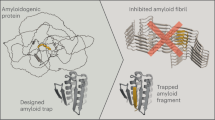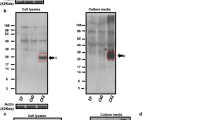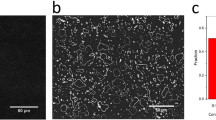Abstract
Amyloids adopt ‘cross-β’ structures composed of long, twisted fibrils with β-strands running perpendicular to the fibril axis. Recently, a toxic peptide was proposed to form amyloid-like cross-α structures in solution, with a planar bilayer-like assembly observed in the crystal structure. Here we crystallographically characterize designed peptides that assemble into spiraling cross-α amyloid-like structures, which resemble twisted β-amyloid fibrils. The peptides form helical dimers, stabilized by packing of small and apolar residues, and the dimers further assemble into cross-α amyloid-like fibrils with superhelical pitches ranging from 170 Å to 200 Å. When a small residue that appeared critical for packing was converted to leucine, it resulted in structural rearrangement to a helical polymer. Fluorescently tagged versions of the designed peptides form puncta in mammalian cells, which recover from photobleaching with markedly different kinetics. These structural folds could be potentially useful for directing in vivo protein assemblies with predetermined spacing and stabilities.
This is a preview of subscription content, access via your institution
Access options
Access Nature and 54 other Nature Portfolio journals
Get Nature+, our best-value online-access subscription
$29.99 / 30 days
cancel any time
Subscribe to this journal
Receive 12 print issues and online access
$259.00 per year
only $21.58 per issue
Buy this article
- Purchase on Springer Link
- Instant access to full article PDF
Prices may be subject to local taxes which are calculated during checkout





Similar content being viewed by others
References
Gazit, E. Self-assembled peptide nanostructures: the design of molecular building blocks and their technological utilization. Chem. Soc. Rev. 36, 1263–1269 (2007).
Shigemitsu, H. & Hamachi, I. Design strategies of stimuli-responsive supramolecular hydrogels relying on structural analyses and cell-mimicking approaches. Acc. Chem. Res. 50, 740–750 (2017).
Shu, J. Y., Panganiban, B. & Xu, T. Peptide-polymer conjugates: from fundamental science to application. Annu. Rev. Phys. Chem. 64, 631–657 (2013).
Riek, R. & Eisenberg, D. S. The activities of amyloids from a structural perspective. Nature 539, 227–235 (2016).
Prusiner, S. B. Cell biology. A unifying role for prions in neurodegenerative diseases. Science 336, 1511–1513 (2012).
Sacchettini, J. C. & Kelly, J. W. Therapeutic strategies for human amyloid diseases. Nat. Rev. Drug Discov. 1, 267–275 (2002).
Toyama, B. H. & Weissman, J. S. Amyloid structure: conformational diversity and consequences. Annu. Rev. Biochem. 80, 557–585 (2011).
Knowles, T. P. & Buehler, M. J. Nanomechanics of functional and pathological amyloid materials. Nat. Nanotechnol. 6, 469–479 (2011).
Rufo, C. M. et al. Short peptides self-assemble to produce catalytic amyloids. Nat. Chem. 6, 303–309 (2014).
Makhlynets, O. V., Gosavi, P. M. & Korendovych, I. V. Short self-assembling peptides are able to bind to copper and activate oxygen. Angew. Chem. Int. Edn Engl. 55, 9017–9020 (2016).
Tena-Solsona, M. et al. Emergent catalytic behavior of self-assembled low molecular weight peptide-based aggregates and hydrogels. Chemistry 22, 6687–6694 (2016).
Friedmann, M. P. et al. Towards prebiotic catalytic amyloids using high throughput screening. PLoS One 10, e0143948 (2015).
Childers, W. S., Ni, R., Mehta, A. K. & Lynn, D. G. Peptide membranes in chemical evolution. Curr. Opin. Chem. Biol. 13, 652–659 (2009).
Tayeb-Fligelman, E. et al. The cytotoxic Staphylococcus aureus PSMα3 reveals a cross-α amyloid-like fibril. Science 355, 831–833 (2017).
Privé, G. G., Anderson, D. H., Wesson, L., Cascio, D. & Eisenberg, D. Packed protein bilayers in the 0.90 A resolution structure of a designed alpha helical bundle. Protein Sci. 8, 1400–1409 (1999).
Patterson, W. R., Anderson, D. H., DeGrado, W. F., Cascio, D. & Eisenberg, D. Centrosymmetric bilayers in the 0.75 A resolution structure of a designed alpha-helical peptide, d,l-Alpha-1. Protein Sci. 8, 1410–1422 (1999).
Egelman, E. H. et al. Structural plasticity of helical nanotubes based on coiled-coil assemblies. Structure 23, 280–289 (2015).
Brunette, T. J. et al. Exploring the repeat protein universe through computational protein design. Nature 528, 580–584 (2015).
Main, E. R., Jackson, S. E. & Regan, L. The folding and design of repeat proteins: reaching a consensus. Curr. Opin. Struct. Biol. 13, 482–489 (2003).
Plückthun, A. Designed ankyrin repeat proteins (DARPins): binding proteins for research, diagnostics, and therapy. Annu. Rev. Pharmacol. Toxicol. 55, 489–511 (2015).
Joh, N. H. et al. De novo design of a transmembrane Zn2+-transporting four-helix bundle. Science 346, 1520–1524 (2014).
Zhang, S.-Q. et al. De novo design of tetranuclear transition metal clusters stabilized by hydrogen-bonded networks in helical bundles. J. Am. Chem. Soc. 140, 1294–1304 (2018).
Eisenberg, D. S. & Sawaya, M. R. Structural studies of amyloid proteins at the molecular level. Annu. Rev. Biochem. 86, 69–95 (2017).
Szczepaniak, K., Lach, G., Bujnicki, J. M. & Dunin-Horkawicz, S. Designability landscape reveals sequence features that define axial helix rotation in four-helical homo-oligomeric antiparallel coiled-coil structures. J. Struct. Biol. 188, 123–133 (2014).
Banner, D. W., Kokkinidis, M. & Tsernoglou, D. Structure of the ColE1 rop protein at 1.7 A resolution. J. Mol. Biol. 196, 657–675 (1987).
Sanders, D. W. et al. Distinct tau prion strains propagate in cells and mice and define different tauopathies. Neuron 82, 1271–1288 (2014).
Prusiner, S. B. et al. Evidence for α-synuclein prions causing multiple system atrophy in humans with parkinsonism. Proc. Natl. Acad. Sci. USA 112, E5308–E5317 (2015).
Thompson, K. E., Bashor, C. J., Lim, W. A. & Keating, A. E. SYNZIP protein interaction toolbox: in vitro and in vivo specifications of heterospecific coiled-coil interaction domains. ACS Synth. Biol. 1, 118–129 (2012).
Fletcher, J. M. et al. A basis set of de novo coiled-coil peptide oligomers for rational protein design and synthetic biology. ACS Synth. Biol. 1, 240–250 (2012).
Banani, S. F., Lee, H. O., Hyman, A. A. & Rosen, M. K. Biomolecular condensates: organizers of cellular biochemistry. Nat. Rev. Mol. Cell Biol. 18, 285–298 (2017).
Kim, C. A., Sawaya, M. R., Cascio, D., Kim, W. & Bowie, J. U. Structural organization of a Sex-comb-on-midleg/polyhomeotic copolymer. J. Biol. Chem. 280, 27769–27775 (2005).
Kim, C. A. & Bowie, J. U. SAM domains: uniform structure, diversity of function. Trends Biochem. Sci. 28, 625–628 (2003).
Wu, H. & Fuxreiter, M. The structure and dynamics of higher-order assemblies: amyloids, signalosomes, and granules. Cell 165, 1055–1066 (2016).
Kuhlman, B. & Baker, D. Native protein sequences are close to optimal for their structures. Proc. Natl. Acad. Sci. USA 97, 10383–10388 (2000).
Otwinowski, Z. & Minor, W. Processing of X-ray diffraction data collected in oscillation mode. Methods Enzymol. 276, 307–326 (1997).
Kabsch, W. Integration, scaling, space-group assignment and post-refinement. Acta Crystallogr. D Biol. Crystallogr. 66, 133–144 (2010).
Emsley, P., Lohkamp, B., Scott, W. G. & Cowtan, K. Features and development of Coot. Acta Crystallogr. D Biol. Crystallogr. 66, 486–501 (2010).
McCoy, A. J. et al. Phaser crystallographic software. J. Appl. Crystallogr. 40, 658–674 (2007).
Murshudov, G. N. et al. REFMAC5 for the refinement of macromolecular crystal structures. Acta Crystallogr. D Biol. Crystallogr. 67, 355–367 (2011).
Winn, M. D. et al. Overview of the CCP4 suite and current developments. Acta Crystallogr. D Biol. Crystallogr. 67, 235–242 (2011).
Adams, P. D. et al. PHENIX: a comprehensive Python-based system for macromolecular structuresolution. Acta Crystallogr. D Biol. Crystallogr. 66, 213–221 (2010).
Acknowledgements
We thank D. Bulkley, P. Jin, S. Li, X. Liu, N. Polizzi, N. Schmidt and H. Wu for technical help. This work was primarily supported by NIH grant R35GM122603 to W.F.D., with additional support from the NSF (CHE1413295) for the MRSEC program to the LRSM at the University of Pennsylvania. H.T.K. was supported by a Ruth L. Kirschstein NRSA Postdoctoral Fellowship (F32GM125217). Y.L. was supported by a Howard Hughes Medical Institute-Helen Hay Whitney Foundation Postdoctoral Fellowship.
Author information
Authors and Affiliations
Contributions
S.-Q.Z. and W.F.D. conceived the project. S.-Q.Z. designed all the peptide sequences and performed in vitro experiments with H.T.K., M.L. and Y.L. H.H. and J.Y. conducted cellular in vivo experiments. L.L. solved and refined all the crystal structures. S.-Q.Z., H.H, J.Y., H.T.K., Y.L., X.S., L.L. and W.F.D. analyzed the data. S.-Q.Z. and W.F.D. prepared the manuscript with contributions from all the authors.
Corresponding authors
Ethics declarations
Competing interests
The authors declare no competing interests.
Additional information
Publisher’s note: Springer Nature remains neutral with regard to jurisdictional claims in published maps and institutional affiliations.
Supplementary information
Supplementary Text and Figures
Supplementary Table 1–2, Supplementary Figures 1–11
Rights and permissions
About this article
Cite this article
Zhang, SQ., Huang, H., Yang, J. et al. Designed peptides that assemble into cross-α amyloid-like structures. Nat Chem Biol 14, 870–875 (2018). https://doi.org/10.1038/s41589-018-0105-5
Received:
Accepted:
Published:
Issue Date:
DOI: https://doi.org/10.1038/s41589-018-0105-5
This article is cited by
-
Staphylococcus aureus functional amyloids catalyze degradation of β-lactam antibiotics
Nature Communications (2023)
-
pH- and concentration-dependent supramolecular assembly of a fungal defensin plectasin variant into helical non-amyloid fibrils
Nature Communications (2022)
-
Intracellular artificial supramolecules based on de novo designed Y15 peptides
Nature Communications (2021)
-
Structural analysis of cross α-helical nanotubes provides insight into the designability of filamentous peptide nanomaterials
Nature Communications (2021)
-
The Human LL-37(17-29) antimicrobial peptide reveals a functional supramolecular structure
Nature Communications (2020)



